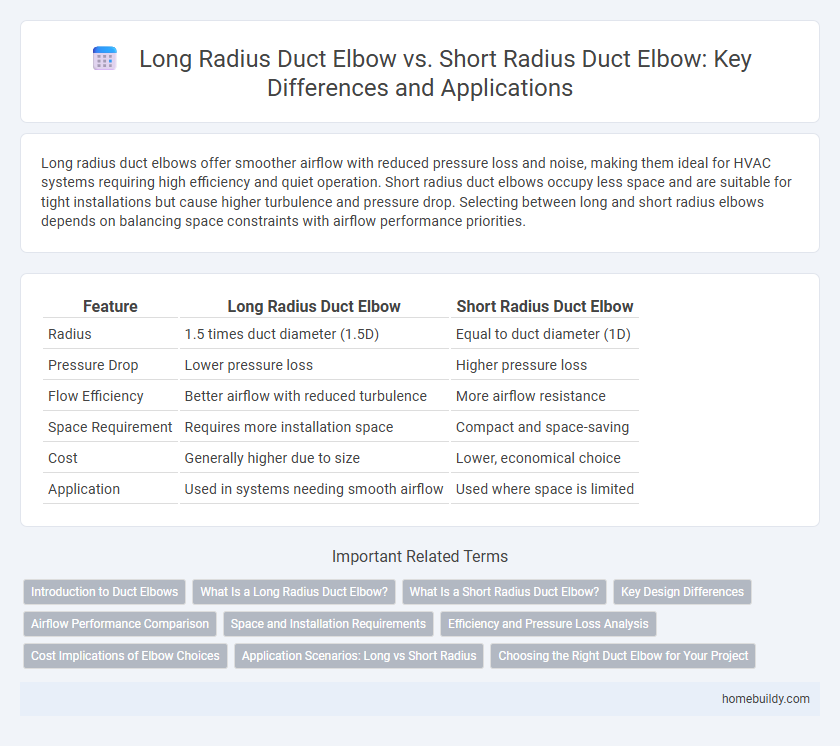Long radius duct elbows offer smoother airflow with reduced pressure loss and noise, making them ideal for HVAC systems requiring high efficiency and quiet operation. Short radius duct elbows occupy less space and are suitable for tight installations but cause higher turbulence and pressure drop. Selecting between long and short radius elbows depends on balancing space constraints with airflow performance priorities.
Table of Comparison
| Feature | Long Radius Duct Elbow | Short Radius Duct Elbow |
|---|---|---|
| Radius | 1.5 times duct diameter (1.5D) | Equal to duct diameter (1D) |
| Pressure Drop | Lower pressure loss | Higher pressure loss |
| Flow Efficiency | Better airflow with reduced turbulence | More airflow resistance |
| Space Requirement | Requires more installation space | Compact and space-saving |
| Cost | Generally higher due to size | Lower, economical choice |
| Application | Used in systems needing smooth airflow | Used where space is limited |
Introduction to Duct Elbows
Duct elbows are essential components in HVAC systems, facilitating directional changes in airflow within ductwork. Long radius duct elbows have a bend radius 1.5 times the diameter of the duct, reducing air friction and pressure loss, while short radius elbows have a bend radius equal to the duct diameter, offering a more compact design but increased resistance. Choosing between long and short radius elbows directly impacts airflow efficiency, system noise, and energy consumption.
What Is a Long Radius Duct Elbow?
A long radius duct elbow has a centerline radius that is 1.5 times the nominal diameter of the duct, allowing for smoother air or fluid flow and reducing pressure loss. It is commonly used in HVAC systems and industrial piping where minimizing turbulence and maintaining efficient flow is critical. Compared to short radius elbows, long radius elbows offer less resistance and reduced noise due to their gradual curvature.
What Is a Short Radius Duct Elbow?
A short radius duct elbow is a duct fitting used to change the direction of airflow within a ventilation or HVAC system with a radius equal to the duct diameter, resulting in a sharper turn compared to long radius elbows. This compact design facilitates installation in confined spaces but can increase air resistance and pressure drop due to the tighter bend. Short radius elbows are commonly used where space constraints outweigh the need for optimal airflow efficiency.
Key Design Differences
Long radius duct elbows feature a bend radius typically 1.5 times the duct diameter, allowing smoother airflow with reduced pressure loss and minimal turbulence. Short radius duct elbows have a bend radius equal to the duct diameter, resulting in a more compact design but higher resistance and increased pressure drop. The choice between long and short radius elbows hinges on balancing spatial constraints against airflow efficiency in HVAC systems.
Airflow Performance Comparison
Long radius duct elbows maintain smoother airflow by reducing turbulence and pressure loss, making them ideal for HVAC systems requiring efficient air distribution. Short radius duct elbows cause higher airflow resistance due to sharper turns, leading to increased energy consumption and potential noise issues. Selecting long radius elbows improves overall system performance by minimizing airflow disruption and enhancing energy efficiency.
Space and Installation Requirements
Long radius duct elbows require more space due to their larger bend radius, making them suitable for installations with ample room and better airflow efficiency. Short radius duct elbows fit into tighter spaces, ideal for compact installations but may cause higher pressure loss and increased turbulence. Installation of long radius elbows demands more clearance, while short radius elbows offer easier fitting in constrained areas with limited space.
Efficiency and Pressure Loss Analysis
Long radius duct elbows reduce pressure loss significantly by minimizing turbulence and maintaining airflow velocity, resulting in higher efficiency compared to short radius elbows. Short radius elbows cause greater pressure drops due to sharper turns, increasing resistance and energy consumption in HVAC systems. Selecting long radius elbows enhances system performance by ensuring smoother airflow and reducing operational costs associated with pressure loss.
Cost Implications of Elbow Choices
Long radius duct elbows generally incur higher initial costs due to increased material usage and manufacturing complexity, but they offer improved airflow efficiency and reduced pressure drops, which can lower long-term operational expenses. Short radius duct elbows are more budget-friendly upfront, requiring less space and material, but they may lead to increased energy consumption and maintenance costs over time because of greater turbulence and pressure loss. Selecting the appropriate elbow type involves balancing immediate budget constraints against potential savings in system performance and energy efficiency.
Application Scenarios: Long vs Short Radius
Long radius duct elbows are ideal for HVAC systems requiring smooth air flow and minimal pressure loss in commercial buildings and large-scale industrial ductwork. Short radius duct elbows suit confined spaces or areas where compact duct routing is essential, such as tight mechanical rooms or retrofit installations. Choosing between long and short radius elbows depends on balancing space constraints with airflow efficiency and pressure drop considerations.
Choosing the Right Duct Elbow for Your Project
Selecting the right duct elbow depends on airflow efficiency and space constraints; long radius duct elbows minimize pressure loss and turbulence, making them ideal for systems requiring smooth airflow and reduced energy consumption. Short radius duct elbows are better suited for compact installations but cause higher pressure drops and increased noise levels. Prioritizing long radius elbows in HVAC designs enhances system performance and longevity, especially in commercial and industrial applications.
Long radius duct elbow vs short radius duct elbow Infographic

 homebuildy.com
homebuildy.com